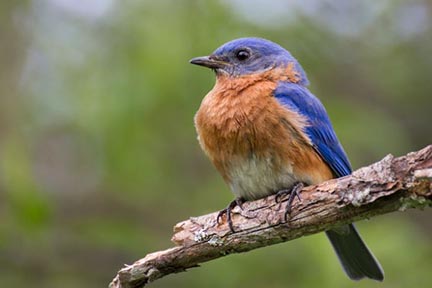| Here are a few of this week’s stories from the Michigan Department of Natural Resources:
See other news releases, Showcasing the DNR stories, photos and other resources at Michigan.gov/DNRPressRoom.
PHOTO FOLDER: Larger, higher-res versions of some of the images used below (wood turtle, wood turtle 2 and brown bats), are available in this folder. Additional pictures (scarlet tanager and kids at Wagner Falls) are available in the DNR public image gallery. The bat house image is available courtesy of the U.S. Fish and Wildlife Service.
 Wood turtles (Glyptemys insculpta) are medium-sized, semiaquatic turtles known for their beautifully sculpted, ridged shells and distinctive orange-yellow markings. In Michigan, they typically are found in clean, fast-flowing rivers and streams with sandy or gravelly bottoms, usually bordered by forests and undeveloped floodplains. Their range in the state includes parts of the northern Lower and Upper peninsulas. Wood turtles (Glyptemys insculpta) are medium-sized, semiaquatic turtles known for their beautifully sculpted, ridged shells and distinctive orange-yellow markings. In Michigan, they typically are found in clean, fast-flowing rivers and streams with sandy or gravelly bottoms, usually bordered by forests and undeveloped floodplains. Their range in the state includes parts of the northern Lower and Upper peninsulas.
“During late spring and summer, wood turtles spend much of their time on land, foraging in fields, forests and floodplains for a variety of foods, including berries, slugs, insects and earthworms,” said Tony Henehan, coordinator of the DNR’s State Willdlife Action Plan.
An idyllic existence, if not for threats like habitat loss, road mortality, nest predation and illegal collection that have decreased population numbers to the point that wood turtles are among Michigan’s Species of Greatest Conservation Need, as identified in that plan.
There’s good news, too, Henehan said. The DNR and its partners have launched several conservation-focused research efforts to solve this challenge. One of the most promising innovations has been the use of detection dogs trained to locate turtles more efficiently in the wild.
The Little Traverse Bay Bands of Odawa Indians Natural Resources Department’s Inland Fish & Wildlife Program has been a key collaborator in these efforts. Each year, LTBB biologists and technicians research and monitor rare turtle species in the 1836 Treaty Ceded Territory of northern Michigan. For the tribe, the wood turtle — Mitig-mishiikenh in Anishinaabemowin — is more than a species of concern; it is a culturally significant animal. Many tribal citizens belong to the Turtle (mishiikenh) Clan, and conserving this species for the next seven generations is both an ecological and cultural priority.
LTBB biologist Bill Parsons said the tribe’s conservation work includes a variety of conventional survey methods to locate and monitor the turtles: float trips along rivers using kayaks or canoes to spot turtles in or near the water, visual surveys along riverbanks and tributaries to assess habitat use, and the use of radio telemetry. |
 “When a turtle is located and captured, it may be marked and fitted with a GPS or radio transmitter to help researchers better understand movement patterns, nesting behavior and habitat preferences,” Parsons said. “When a turtle is located and captured, it may be marked and fitted with a GPS or radio transmitter to help researchers better understand movement patterns, nesting behavior and habitat preferences,” Parsons said.
While effective, these methods can be time-consuming and labor-intensive — especially in dense vegetation or rugged terrain where turtles are difficult to spot. In response, LTBB has adopted a novel and increasingly effective tool: detection dogs. These dogs are trained to sniff out turtles based on their scent, allowing researchers to locate individuals that would otherwise go unnoticed. The dogs can quickly cover large areas and reduce human disturbance in sensitive habitats.
Working with his trained Labradoodle, Mooz, Parsons has found dozens of turtles and nest sites using this approach over the past five years. The use of detection dogs is proving to be a game-changer, not only for wood turtle conservation but potentially for locating other rare species in Michigan as well – all in all, a pretty doggone good deal.
Seeing Michigan’s wood turtles up close is a memorable experience, and the summer months are a great time to find them. Just remember not to touch or collect turtles, except if one is crossing the road. If it’s safe to do so, feel free to lend a hand and help it across in the direction it was headed.
Questions? Contact Tony Henehan at HenehanT@Michigan.gov. |
 Next time you’re about to head to your favorite Michigan state park, be sure to first check out new curated Michigan Field Guides – this special collection offers insights into local wildlife, native plants and outdoor adventures. Next time you’re about to head to your favorite Michigan state park, be sure to first check out new curated Michigan Field Guides – this special collection offers insights into local wildlife, native plants and outdoor adventures.
Offering these guides is part of a new partnership between the Library of Michigan and the DNR.
“We’re so excited about this collaboration aimed at enriching the outdoor experiences of residents and visitors to our beautiful state,” said Maia Turek, engagement and innovations specialist for the DNR Parks and Recreation Division. “One of the best things about this new partnership is that these guides are free to access through the Library of Michigan’s ReadMichigan.org e-book platform.”
With detailed information on flora, fauna, geology and other natural features, the Michigan Field Guides will now be easily accessible to anyone with a mobile device. Whether identifying wildflowers along the trails, spotting native birds or learning about Michigan’s unique ecosystems, users can dive deeper into the natural world around them.
The guides are available for instant use at ReadMichigan.org, a free resource provided by the Library of Michigan that offers access to Michigan-based e-books and educational materials with no wait lists or holds to Michigan residents or visitors anywhere within the state. |
 “This collaboration makes it easier than ever for people to connect with our state’s rich story and natural environment,” said State Librarian Randy Riley. “ReadMichigan.org helps us bridge the gap between experiencing nature and understanding it, presenting real-time learning opportunities while exploring Michigan’s great outdoors.” “This collaboration makes it easier than ever for people to connect with our state’s rich story and natural environment,” said State Librarian Randy Riley. “ReadMichigan.org helps us bridge the gap between experiencing nature and understanding it, presenting real-time learning opportunities while exploring Michigan’s great outdoors.”
ReadMichigan.org was initially developed by the Library of Michigan in collaboration with Michigan Humanities and the presses of University of Michigan, Michigan State University and Wayne State University to create a unique collection of regional e-books available to all Michigan residents. The collection has expanded to include many past Michigan Notable Books selections, titles by Michigan poets, and local histories of towns and cities across the state.
This newest partnership underscores Michigan’s commitment to accessible learning and environmental awareness for all ages and is part of a broader effort to enhance the visitor experience across Michigan’s 100-plus state parks.
The Library of Michigan is an agency within the Michigan Department of Education and is dedicated to providing the people of this state and their government with one perpetual institution to collect, preserve and provide access to the story of the state, and to support libraries in their role as essential community anchors. Learn more at Michigan.gov/LibraryofMichigan.
Questions? Contact Maia Turek at 989-225-8573. |
 After a devastating 90% population decline from white-nose syndrome, Michigan’s bats are slowly stabilizing – but they could still use our help. Reporting your sightings of bats using roosts is one way to help scientists monitor and support bat recovery. After a devastating 90% population decline from white-nose syndrome, Michigan’s bats are slowly stabilizing – but they could still use our help. Reporting your sightings of bats using roosts is one way to help scientists monitor and support bat recovery.
Warmer days mean that Michigan bats are on the move. If you’ve seen bats flying from trees, chimneys, bridges or other structures around dusk, you may have spotted a bat roost. These are places where bats rest and raise pups.
“Roosts are a key part of a bat’s life cycle, but we still don’t fully understand how and where bats are using them across Michigan,” said DNR bat specialist John DePue. “That’s where people can help. By reporting roosts, you provide valuable data to guide conservation efforts.”
Reporting roosts
The new Michigan Bat Roost Monitoring Program, launched in partnership with the Michigan Natural Features Inventory and the DNR, invites community members to become “roost spotters.” If you observe bats regularly entering and exiting a tree, building, bridge or other structure during sunrise or sunset, it is likely a roost site and should be reported.
“You don’t need a science background, just a notepad, a flashlight and a bit of time,” said Nicolette Sexton, research assistant with the Michigan Natural Features Inventory. “This is an easy and rewarding way to connect with nature and make a real difference for our native bat species.”
To participate, open the survey page and plug in location information for the roost. Photos of the roost are helpful, but please don’t get too close; disturbing a roost can harm the bats. |
Vital species, vulnerable status
Of Michigan’s nine bat species, five are listed as threatened or endangered. In the wake of white-nose syndrome and other challenges, such as loss of habitat, scientists need more information on bat biology – especially where they roost.
Bats are the only flying mammal species and are essential to our ecosystems and agriculture. These insectivores feed on spongy moth, tent caterpillars, fruit worms and other crop-damaging insects, saving an estimated $23 billion in annual pest control costs to U.S. farmers.
Bat roosts in buildings
 If you discover bats in your attic, avoid evicting them between mid-May and late July, when young bats are unable to fly. Instead, wait until August to install a one-way exclusion device. You may also consider installing a bat house nearby to give them a new place to roost. Get instructions for building or buying a bat house and guidance on where to install it on the Bat Conservation International bat house website. If you discover bats in your attic, avoid evicting them between mid-May and late July, when young bats are unable to fly. Instead, wait until August to install a one-way exclusion device. You may also consider installing a bat house nearby to give them a new place to roost. Get instructions for building or buying a bat house and guidance on where to install it on the Bat Conservation International bat house website.
If you suspect someone has been bitten by or had direct exposure to a bat, contact your local health department, as bats can carry rabies. If a pet may have been exposed, contact your veterinarian.
Take action for bats
If you’re out enjoying a summer sunset and see bats using a roost, let us know. It takes just three short minutes to submit a report that can have a lasting impact on bat conservation. Learn more at Michigan.gov/Bats.
Questions? Contact Nicolette Sexton at SextonN@Michigan.gov. |
 See more pictures by Michigan state parks photo ambassadors at Instagram.com/MiStateParks. For more on the program, call Stephanie Yancer at 989-274-6182. (This photo is by Samantha Bohon, for the Michigan DNR, at Two Hearted River State Forest Campground in Luce County.) See more pictures by Michigan state parks photo ambassadors at Instagram.com/MiStateParks. For more on the program, call Stephanie Yancer at 989-274-6182. (This photo is by Samantha Bohon, for the Michigan DNR, at Two Hearted River State Forest Campground in Luce County.)
|






 Wood turtles (Glyptemys insculpta) are medium-sized, semiaquatic turtles known for their beautifully sculpted, ridged shells and distinctive orange-yellow markings. In Michigan, they typically are found in clean, fast-flowing rivers and streams with sandy or gravelly bottoms, usually bordered by forests and undeveloped floodplains. Their range in the state includes parts of the northern Lower and Upper peninsulas.
Wood turtles (Glyptemys insculpta) are medium-sized, semiaquatic turtles known for their beautifully sculpted, ridged shells and distinctive orange-yellow markings. In Michigan, they typically are found in clean, fast-flowing rivers and streams with sandy or gravelly bottoms, usually bordered by forests and undeveloped floodplains. Their range in the state includes parts of the northern Lower and Upper peninsulas.
 “When a turtle is located and captured, it may be marked and fitted with a GPS or radio transmitter to help researchers better understand movement patterns, nesting behavior and habitat preferences,” Parsons said.
“When a turtle is located and captured, it may be marked and fitted with a GPS or radio transmitter to help researchers better understand movement patterns, nesting behavior and habitat preferences,” Parsons said.
 Next time you’re about to head to your favorite Michigan state park, be sure to first check out new curated
Next time you’re about to head to your favorite Michigan state park, be sure to first check out new curated  “This collaboration makes it easier than ever for people to connect with our state’s rich story and natural environment,” said State Librarian Randy Riley. “ReadMichigan.org helps us bridge the gap between experiencing nature and understanding it, presenting real-time learning opportunities while exploring Michigan’s great outdoors.”
“This collaboration makes it easier than ever for people to connect with our state’s rich story and natural environment,” said State Librarian Randy Riley. “ReadMichigan.org helps us bridge the gap between experiencing nature and understanding it, presenting real-time learning opportunities while exploring Michigan’s great outdoors.”
 After a devastating 90% population decline from white-nose syndrome, Michigan’s bats are slowly stabilizing – but they could still use our help. Reporting your sightings of bats using roosts is one way to help scientists monitor and support bat recovery.
After a devastating 90% population decline from white-nose syndrome, Michigan’s bats are slowly stabilizing – but they could still use our help. Reporting your sightings of bats using roosts is one way to help scientists monitor and support bat recovery.
 If you discover bats in your attic, avoid evicting them between mid-May and late July, when young bats are unable to fly. Instead, wait until August to install a one-way exclusion device. You may also consider installing a bat house nearby to give them a new place to roost. Get instructions for building or buying a bat house and guidance on where to install it on the Bat Conservation International
If you discover bats in your attic, avoid evicting them between mid-May and late July, when young bats are unable to fly. Instead, wait until August to install a one-way exclusion device. You may also consider installing a bat house nearby to give them a new place to roost. Get instructions for building or buying a bat house and guidance on where to install it on the Bat Conservation International  See more pictures by
See more pictures by 





